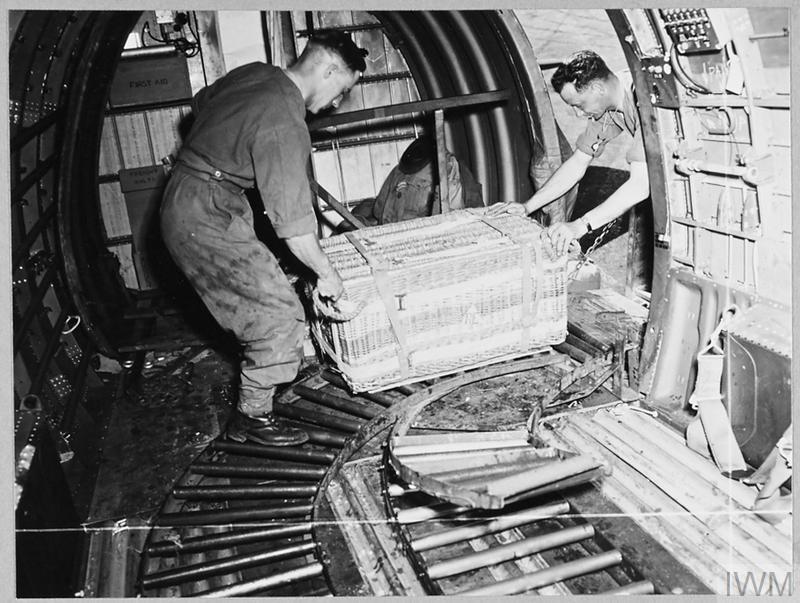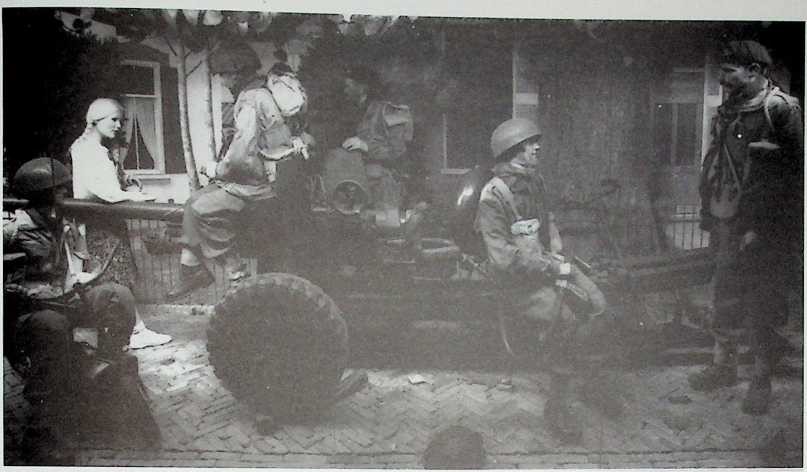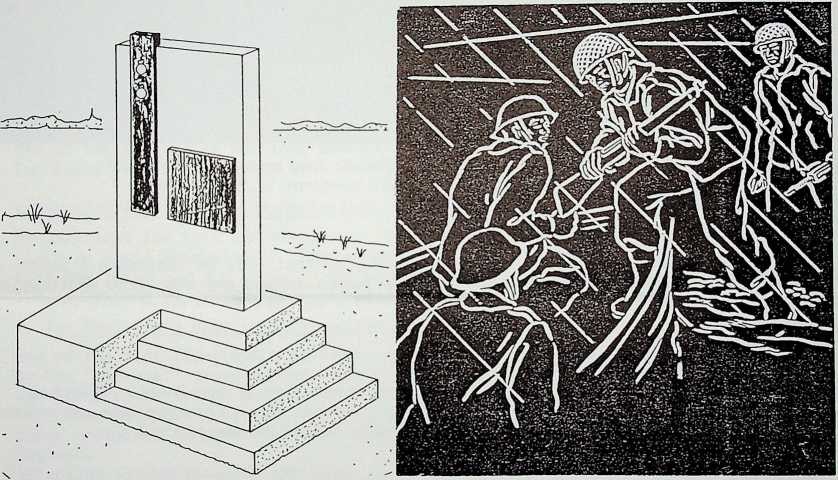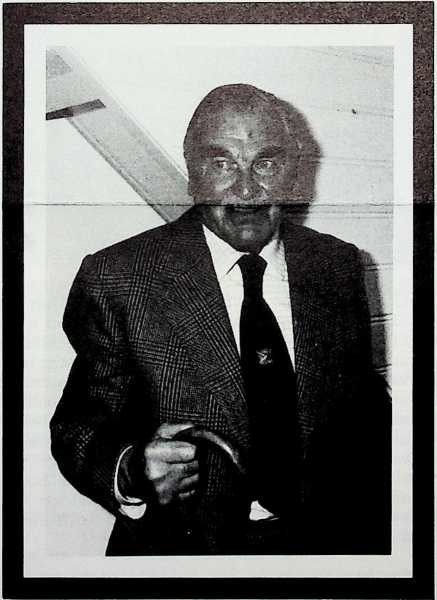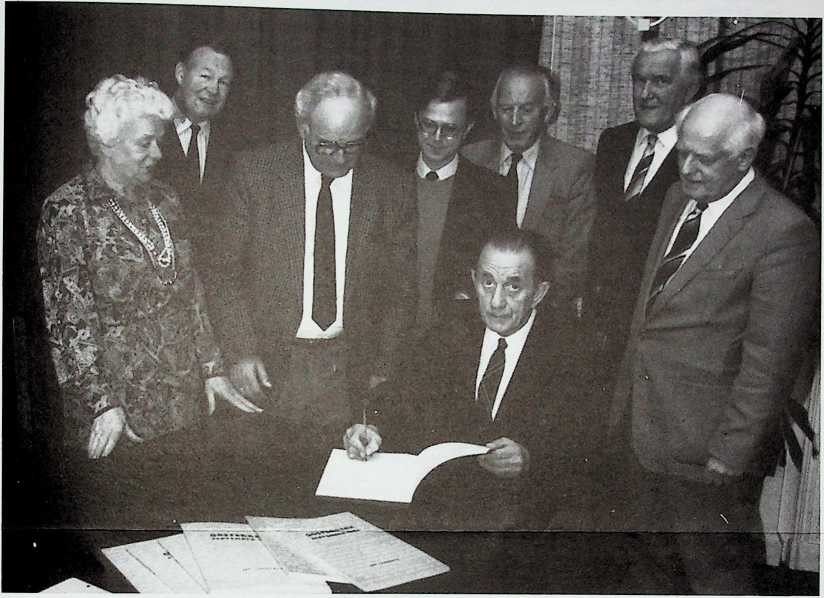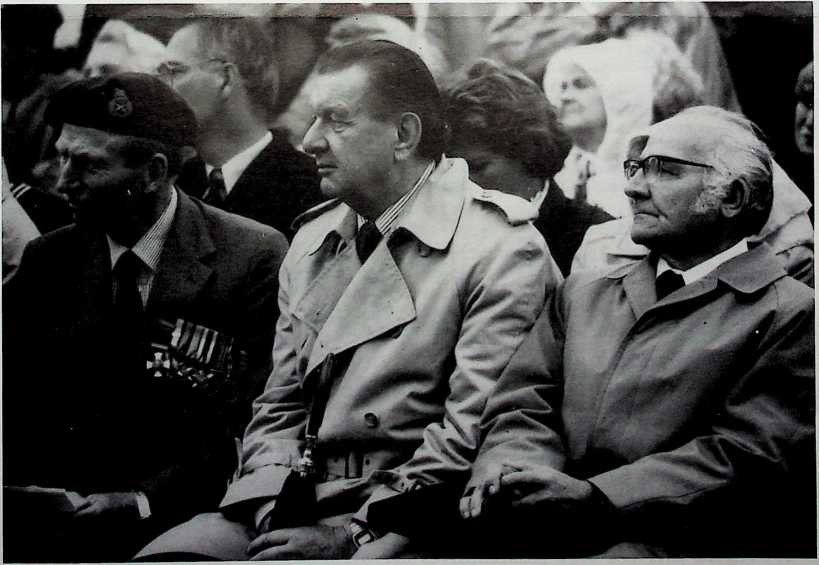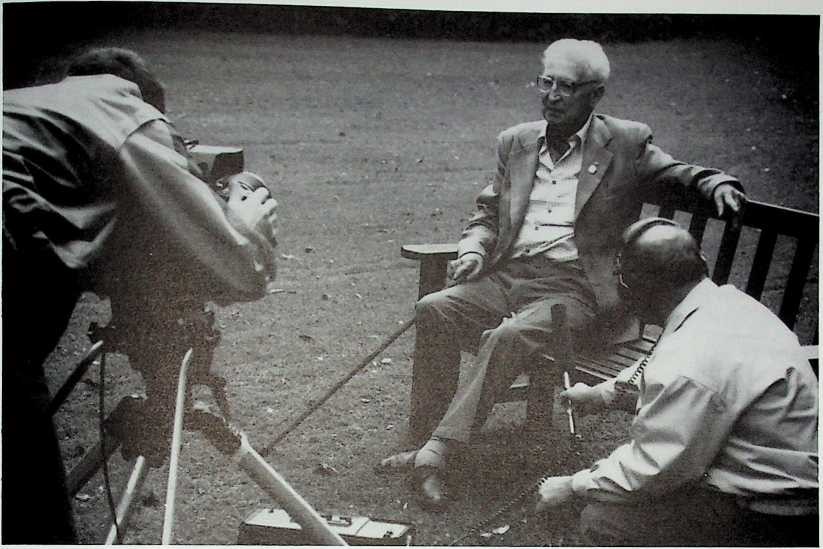FRIENDS OF THE AIRBORNE MUSEUM
Editors: Drs. R.P.G.A. Voskuil C. van Roekel G.H. Maassen jr.
Representative in Great Britain: Niall Cherry, 3 Church Road, Warton, Lancs, PR4 1BD Tel. home 0177-2632764
Newsletter No. 78, May 2000 Translated by Cathrien and Peter Clark
 Mr M. Kremer of the Dutch Air Mobile Brigade, and Mr J. Elliott, the youngest British Air Despatcher, press the button simultaneously, to open the ‘Green On’ exhibition in the Airborne Museum ‘Hartenstein’ on 19 April 2000.
Mr M. Kremer of the Dutch Air Mobile Brigade, and Mr J. Elliott, the youngest British Air Despatcher, press the button simultaneously, to open the ‘Green On’ exhibition in the Airborne Museum ‘Hartenstein’ on 19 April 2000.
(Photo: Berry de Reus)
‘Green On’ exhibition opened
The exhibition ‘”Green On’, Air Despatchers, the forgotten heroes of Arnhem” opened in the Airborne Museum ‘Hartenstein’ on Wednesday 19 April last. The opening ceremony was performed by J. Elliot, the youngest member of the 47th Air Despatch Squadron from England, and M. Kremer, the youngest member of the Dutch Air Mobile Brigade. Although ground units were supplied from the air in a rough and ready manner during the First World War, it was not until the Second World War that this system was applied on a large scale. Weapons and explosives were already being dropped to resistance groups in occupied territory from the very beginning of the war. This early experience showed that the packing of equipment and its dropping from aircraft was a job for specialists, and in order to fulfil this task men of the Royal Army Service Corps were trained to become so-called Air Despatchers.
During the Battle of Arnhem, 600 re-supply sorties were flown by Stirlings and Dakotas between 18 and 25 September. 426 Air Despatchers were involved in these operations, some of them making more than one flight. Eighty-four aircraft were lost and, as far as is known, 78 Air Despatchers were killed. Fifteen hundred tons of material were dropped, with just 7.4 % falling into British hands. Poor communications with Britain meant that the authorities there could not be informed on time that the supply dropping zones were in German hands. After the war much attention was paid to the airmen who risked their lives, but the men who actually had to eject the supplies from the aircraft were virtually overlooked. It was not until 1994 that a monument to the Air Despatchers who died at Arnhem was raised in Oosterbeek.
The history of the British Air Despatchers, including their more recent role in humanitarian operations, is brought to life in this exhibition by means of a diorama, various objects and artefacts, photographs and documents. The ‘Green On’ exhibition continues until 5 November 2000.
Management changes: ‘A time to come and a time go’.
At the AGM held on 15 April last we had to say out- fond farewells to three people who have meant an awful lot to the society for a very long time: Mrs Mieke de Langen, Mr Wim de Ruijter and Mr Ted Shaw.

Mieke de Langen became our secretary in 1982, a role she fulfilled enthusiastically and meticulously. On top of this she had the job of managing our stocks. On countless occasions, such as Army and Air Force open days and organised walks, she managed to present these wares to the attending public. In her Ex management board members Mieke de Langen, Rinke Fennema and Wim de Ruijter were made Members of Merit during the AGM on 15 April last. Chairman Chris van Roekel presents each of them with a Pegasus statuette as a token of appreciation for their efforts.
(Photo: Mrs H. Kolster)
own inimitable style she earned many a remarkable sum of money for our society. Without this it would have been impossible for us to maintain our contributions at their present level, contributions that go mainly to the museum and the Newsletter.
She made her views known with verve at numerous meetings, and her business acumen and wisdom enabled her to contribute to the decision-making process on several occasions. Over the years all this effort involved a fair few car trips from Hoevelaken. Wim de Ruijter has been of inestimable value to our museum and society. Hundreds of high -quality photographs decorate the walls of the ‘Hartenstein’ and have appeared in our Newsletters. He assisted in the compiling and preparation for posting of thousands of school projects and Newsletters.
Nothing was ever too much for him. In 1984 he became a management board member, and he still travels every Tuesday from Duiven to the museum to carry out odd jobs about the place.
Both board members have been of immense worth to the museum and society, and it was with great pleasure that they were unanimously nominated ‘Member of Merit’ during our 20th AGM. Fortunately, despite the fact that they intend taking things easier, they agreed with our proposal that Mieke should continue to man the ‘shop’ at meetings and on theme days, and that Wim would continue to look after the photographic work.
The third person to whom we say farewell is Mr Ted Shaw, MC. As a lieutenant and troop commander with the 1st Anti-Tank Battery, he won the Military Cross at Arnhem. After the war he remained closely involved with the commemorations in Oosterbeek. For nine years he has represented our society for the British members in his modest but secure manner, but now, at the age of 82, he is handing this job over to Niall Cherry, one of our younger UK members. Niall is the author of the recently published book about the medical service of the 1st British Airborne Division, ‘Red Berets and Red Crosses’.
During the AGM we also had the pleasure of welcoming two new members to the management team. Gerard Gijsberts and Ben Kolster were appointed secretary and board member (duties to include public relations) respectively. We have great confidence in their abilities and wish them an enjoyable time as board members.
It was decided during the 1999 AGM to introduce the title ‘Member of Merit’ for those who have been of particularly special significance to the society. Our retiring chairman Mr Jan Smits was the first to receive this honourable title. However, during the same AGM the board proposed that Mr Rinke Fennema, our treasurer for many years, should still be made ‘Member of Merit’.
(C. van Roekel)


Ben Kolster and Gerard Gijsberts were appointed members of the board of management at the AGM of 15 April 2000. (Photos: Mrs H. Kolster and, through, G. Gijsberts)
New British representative
The Society’s new UK representative is Mr Niall M.G. Cherry, 3 Church Road, Warton, Lancs PR4 1BD, UK. Telephone (home) 01772632764, (work) 0177284593, e-mail address; Niall.Cherry@bae.co.uk. Our British members are requested to direct all correspondence, orders of goods and payments to him.

Our new UK representative is Niall Cherry, also known for his book about the medical services of the 1st British Airborne Division, that was published last year, ‘Red Berets and Red Crosses’. (Photo: R. Voskuil, September 1999)
‘Silent Invader’
On a recent visit to the Museum of Army Flying in Middle Wallop I came across a remarkable book entitled ‘Silent Invader’. It was written by Captain J.A. Morrison, commander of No. 5 Flight The Glider Pilot Regiment, at the Battle of Arnhem. He came to this regiment as a volunteer, having first served with me Honourable Artillery Company and The Royal Fusiliers Regiment. In a racy manner, and in fewer than thirty pages, he describes his prior history and his training in Horsa gliders. On June 6 1944 he lands in Normandy with a unit of the Ox & Bucks (The Oxfordshire and Buckinghamshire Light Infantry). Because glider pilots are not expected to take part in the fighting for any length of time, Morrison is back in England by 11 June. He subsequently lands with a unit of an Anti-Tank Battery on landing zone ‘Z’ at Wolfheze on 18 September 1944.
Next day he and a number of other pilots lose contact with the rest of the division. After a few days being hidden by civilians he nevertheless ends up in a German POW camp. Via Stalag 12A and interrogation by the Gestapo he eventually arrives at Stalag Luft 1. More than half of the book is given over to describing life in this camp, full of officers from various countries. With the approach of the Russians the detainees free themselves, even taking over a nearby airfield with the intention of liberating a few more camps.
All in all an exceptional book which shows yet another side of the Battle of Arnhem, and especially what happened afterwards. As the 1998 exhibition ‘Liberators behind Barbed Wire’ said:
6500 prisoners-of-war means 6500 different stories. Without doubt, this is a story worth reading.
‘Silent Invader, A glider pilot’s story of the invasion of Europe in World War IT by Alexander Morrison is published by Airlift Publishing Ltd., 101 Longden Road, Shrewsbury SY3 9EB, England. The book is illustrated with photographs, comprises 160 pages, costs 19 pounds 95p, and the ISBN no. is 1 84037 058 0. (W. Boersma)
Ordering Newsletter back issues
We regularly receive requests from many members in the Netherlands for back issues of the Newsletter and Ministory. Up until now we have maintained a fixed price of 50 guilders per complete set. Having in the meantime reached numbers 78 and 66 respectively, we consider it time for a price review, partially due to increased printing costs. Therefore, from now on a Newsletter plus Ministory will cost 1 guilder 50. You can indicate the issue number(s) required and fill in the necessary amount on your cheque. An extra 5 guilders should be added to cover postage and packing.
If the Dutch edition of a specific issue is no longer available we reserve the right to send you the English version.
(C. van Roekel)
Subscription to ‘ The Eagle’
For many years the Glider Pilot Regimental Association has published its own magazine, ‘The Eagle’. Till now this periodical was only sent to ex-glider pilots and those having a special link with this regiment.
However, since 1 January this year anyone with an interest in this subject can take out a subscription to
‘The Eagle’. A subscriber in the Netherlands will pay 18 pound per annum, and for this he/she will receive three copies per year of this excellent magazine, each containing articles on the use of gliders both during and shortly after the Second World War. Each copy pays great attention to the landings in Normandy, Arnhem and Hamminkeln. The history of pilot training also receives extensive cover. The magazine is printed on glossy paper, is beautifully presented and well illustrated with photographs, maps and drawings.
If you are interested in a subscription to ‘The Eagle’, send a cheque for 18 pounds (British currency please!) to Mr David Brook, Birds Hill, Gt. Bealings, Woodbridge, Suffolk IP13 6NR, England. Tel. 01394 382285.
In memoriam: Corporal Tom Italiaander
Tom Italiaander passed away at his home in Bilthoven on 28 March 2000. Tom was born in Rotterdam on 29 April 1914. He is working for BPM in South America at the outbreak of the Second World War, and after terminating his contract volunteers for service with the Dutch army in Canada on 29 October 1941. He eventually joins No.
2 (Dutch) Troop No. 10 (Inter Allied) Commando via the Prinses Irene Brigade. Following training in Scotland, Port Madog in Wales and Eastborne in South England, he and No. 2 Troop leave for India. By August 1944 he is again back in England. Along with twelve other Dutch commandos he is attached to the 1st British Airborne Division.
On 17 September 1944 he lands at Wolfheze with the 1st Airborne Reconnaissance Squadron. Next day, he and fellow commando Van der Meer are photographed by AFPU photographer Dennis Smith meeting two Wolfheze ladies in Duitsekampweg. This photo has been used many times in publications about the Battle of Arnhem. (Editor’s note: most recently in ‘Blik Omhoog IT by Cor Janse, page 798). During the battle Italiaander acts mainly as courier between the various British units. One of his jobs is the daily passing on of radio frequencies. When the evacuation takes place he manages to cross back over the Rhine along with the remnants of the division.
He takes part in the Walcheren landings in November 1944, and leaves military service in 1945 with the rank of sergeant. For his part in these two actions in the Netherlands he receives the decoration of the Bronze Lion.
Tom Italiaander visited the Airborne Museum on numerous occasions. Last year he and his wife were guests of the museum on our society’s boat trip. The management of the Airborne Museum Foundation and Friends’ Society wish his wife, children and granddaughter much strength and courage on the sad loss of a husband, father and grandfather.
(W. Boersma)
Workgroup ‘ Westgruppe’
Because, compared to the allied side, there is still very little known about the history of the German army units that were involved in the Battle of Arnhem under General Von Tettau, Geert Maassen, Hans Timmerman and Peter Vrolijk have decided to work together on a research project into the so-called ‘Von Tettau Division’, also known as the ‘Westgruppe’. Their eventual aim is to publish their findings in book form.
The Von Tettau Division consisted of all the German units that attacked the British and Polish positions from the west, while the remainder of 9th SS Panzer Division, plus a large number of other units that had been placed under its command, attacked from the east and north.
Anyone who may be able and willing to provide information on this subject, such as stories, documents, eye-witness accounts, newspaper reports, magazine articles, photographs or books are kindly asked to contact Geert Maassen during office hours on 026 3348303. You can also write to: The Renkum Municipal Archives, f.a.o. G.H. Maassen, PO Box 9100, 6860 HA, Oosterbeek.
(Peter Vrolijk)
Comment on: ‘ From the archives (2)’
In the previous Newsletter Mr A. Groeneweg, BA, the Airborne Museum archivist, wrote an article which included a piece about Corporal Arthur Maybury (89th Parachute Security Section, Intelligence Corps), who was killed on 17 September 1944. The following comments might be worth noting.
Among other things, Groeneweg states that, according to the Roll of Honour, Maybury’s field grave was found in 1945 “‘in the garden of a bungalow on Utrechtseweg, Oosterbeek.’ This probably refers to the garden of the Berghege family, where the ABN-AMRO bank now stands”. In addition he recalls an interview with Miss Wilhelmina Schouten, deputy headmistress of the Domestic Science School on Rijnkade in Arnhem in 1944. She says that Maybury was buried in the back garden of the school. Archivist Groeneweg then asks himself: ‘Why would people from Arnhem or Oosterbeek exhume the remains of a British soldier originally buried in a garden on Rijnkade and re¬bury them in a garden in Oosterbeek?’ Mr Groeneweg is on the wrong track.
In the first place, the latest edition of the Roll of Honour has the following to say about Maybury: “‘The original FB was in the garden of the Huishoudschool, Rijnkade, Arnhem, map 40-23-6. His body was removed later by the Germans and taken to an undisclosed location. The CWGC (Commonwealth War Graves Commission) registers read ‘in garden of bungalow along Utrechtseweg'”. This information comes from the following sources. The Arnhemse Koerier of 8 May 1996 says about Maybury: ‘German SS demand the body of the dead
British soldier buried in the school garden . The Arnhemse Courant (19 September 1998) also reports: ‘The Germans arrived later and demanded that the body be handed over’. Miss Schouten herself says (in the magazine ‘De Tweede Wereldoorlog – Met eigen ogen’, 1996 [The Second World War – With my own eyes]) that there was a loud hammering on the back door of the school on Monday 18 September, and that there stood a German who asked if there was a dead Englishman in the school. Wilhelmina denied that there was, but her story makes it clear that the enemy was probably well aware of Maybury’s death. The CWGC made available copies of the relevant Graves Registration Report Form and the Graves Concentration Report Form. From these it would appear that Maybury’s remains were exhumed from his field grave on 10 September 1945, and re-interred in the Oosterbeek war cemetery. The field grave location is given as: Tn garden of bungalow’, with 693783 as the associated map co-ordinates. The names of Gunner W.N. Howard, Lieutenant C.E.P. Sankey, Private A.H.A. Boland and Private W.H. Reeve are noted on the above form at the same field grave location and map co-ordinates.
A problem now arises because the map co-ordinates point to a house along Utrechtseweg in Oosterbeek, near the Hartenstein estate. And we know that Private Reeve fought at the bridge in Arnhem (see photo on page 65 of the Roll of Honour). There is also a photo of Sankey’s grave (page 17 of the Roll), and this location can be found in the front garden of the Berghege house mentioned by Groeneweg. Are you still with me?
In any case, based on the above, and as co-producer of the new Roll, I came to the conclusion that Maybury was originally buried in the back garden of the Huishoudschool, and that the Germans exhumed the body and took it elsewhere. Where exactly is not known, since according to me the CWGC forms contain errors in this case, and are unreliable.
On top of this, Groeneweg’s article states that Maybury belonged to the 89th Field Security Section. The Roll of Honour talks of the 89th Parachute Security Section (page 53) and the 89 Parachute Field Security Section (page 3). Finally, the ‘Who was Who’ mentions the 89th Parachute Field Security Section as well. Which is correct?
(Geert Maassen)
Correction
Mr Groeneweg informs us that, contrary to that written in his article ‘From the Archives (2)’, Sir John Killick is, happily, not dead. A report from England tells us that he is very much alive, albeit in poor health.
A German photo
Some years ago one of our members began researching details on the German war photographer Oberscharfiihrer Peter Josef Adendorf. The investigation led to many places, including the Frihedsmuseet in Copenhagen. One of the photos sent to the Netherlands from Denmark is printed here. The original caption reads:
Der deutsche Widerstand im Westen verstarkt. Die entschlossene Gegenwehr der deutschen im Westen eingesetzten Truppen, hat die von den Anglo-Amerikanern unternommene Offensive, die zur schnellen Eroberung Deutschlands fuhren sollte, zum Stehen gebracht. Selbst nach eigenen Aussagen des Feindes sind seine Verluste uber Erwarten hoch. Die Enttausschung von Arnheim. Grenadiere des Heeres marschieren als Verstarkung nach vorn, wahrend gefangene Briten die Strassen von den Trummern voraufgegangener Kampfe saubem.
SS-PK-Adendorf – 3482 Orbis 1 E.M.
[The determined resistance of the Germans deployed in the West brought to a halt the Anglo-American offensive that should have led to the rapid defeat of Germany. Even according to the enemy’s own reports, their losses were higher than e,xpected..
The setback of Arnhem. Army grenadier reinforcements advance while captured British clear the streets of the aftermath (rubbish/rubble) of battle.
SS-PK-Adendorf – 3482 Orbis 1 E.M.] Assuming that the photograph was indeed taken in the Arnhem/Oosterbeek area, we would like to know precisely where. Does anyone recognise something or somebody? And what does 3482 Orbis 1 E.M. mean?

SS-PK-Kriegsberichter Adendorf used his camera in the Arnhem region in September 1944.
In the foreground, German soldiers on the way to the fronK?); behind them and to the left, British prisoners-of-war clear iip/collect(?) material (including a supply container).
Who knows exactly where this photo was taken?
(Photo: Frihedsmuseet, Copenhagen)
Your reactions would be received with interest by the editors via Geert Maassen (c/o Gemeentearchief Renkum, PO Box 9100, 6860 HA, Oosterbeek; tel 026 3348303).
In Memoriam: Mr P.R.A. van Iddekinge BA
News has reached us that Mr P.R.A. van Iddekinge BA passed away on 29 April last at the age of 66. Piet van Iddekinge started work in the Arnhem Municipal Archives in 1959. Thirty years later he became municipal archivist, a position he held up to his retirement in May 1999.
Piet was a great expert on the history of the Second World War, and in particular the Battle of Arnhem. He wrote various publications on this subject including the well-known books ‘Arnhem, September 1944’ (1969) and ‘Arnhem 44/45, evacuatie, verwoesting, plundering, bevrijding, terugkeer’ [Arnhem 44/45, evacuation, destruction, plundering, liberation, return] (1981). Last year, to mark his farewell, the booklet ‘Arnhem Sextet, opstellen voor drs P.R.A. van Iddekinge’ (Arnhem)
Sextet, essays for drs P.R.A. van Iddekinge) was published. At the back is a list of no less than 52 titles of publications that he wrote.
The archivist was greatly interested in the Airborne Museum and the Friend’s Society. We made many appeals to him over the years, appeals that were never refused. The last time was in August last year. Then he wrote the chapter, ‘German war photographers in September 1944’ in Ministory No. 63 (appendix to Newsletter No. 75).
It is difficult to believe that Piet van Iddekinge is no more. We shall miss him, and we wish his family the strength to cope with their tragic loss.
(Robert Voskuil)
De Tafelberg (conclusion?)
Since 1998 we have been keeping an eye on the developments that could lead to the complete demolition of Huize ‘de Tafelberg’, and the building in its place of luxury apartments.
The management strongly advocated that an historic part of the original building should be retained, namely the part that still recalls the Battle of Arnhem, when it served as an emergency hospital. In common with the Airborne Museum Foundation, the ‘Stichting voor Heemkunde’ and the ‘Vereniging Vijf Dorpen in ‘t Groen’, we wrote to the local authority in January 1998 requesting that the building be placed on the municipal monuments list. Three months later, and as a result of this request, the Municipal Monuments Commission recommended to the B&W (Burgomaster and Aidermen) college that the front elevation and hall should be declared monuments.
After an extremely long period, during which time much was discussed and written about this internationally famous site, also partly due to the film ‘Theirs is the Glory’ (1946), the local authority decided on 16 February 2000 to accept this recommendation. Since that day, the front section of the building (the front elevation, hall, staircase and wainscoting) have been protected. This will include the windows in the front elevation, which will be restored to their 1944 state.
The terrazzo floor which, because of the still-visible bloodstains it bears, is of tremendous emotional value, resulted for a while in a difference of opinion between the project developer and the Friends. The authorities had understanding for our viewpoint on this as well, but from the ‘building-technical’ aspect, following consultation with national experts, the cracks and other damage could not be repaired to the satisfaction of the present owner. A compromise was arrived at regarding the retention of this historical artefact. A reasonable part of the floor, 2 m x 1.5 m, bearing the characteristic marks about which we are talking, will therefore be included in the wall next to the staircase.
Confronted with the facts, we had no alternative but to go along with this. At the same time we offered to put forward proposals for highlighting the historical significance of De Tafelberg when it is furnished. Everything considered, and taking into account the much time and energy it cost, we think we achieved an acceptable result.
C. van Roekel)
Keevil Website
The village of Keevil in Wiltshire, England, now has its own internet website. It is from Keevil Airfield that many gliders left to take part in operation Market on September 1944, and numerous re-supply missions were flown from Keevil to the Arnhem area during the course of the operation. Keevil was also one of the airfields used for operation Overlord in June 1944.
Although the site principally features the village, one of the prettiest in the region, it also contains a detailed section on the airfield itself, from its construction to its present day use.
Keevil can be found on:http: /1 www.rward.clara.net/index.htm.
(P. Clark)
‘ White Raven’ sought
In our operating account for 1999 you will have come across the heading ‘diverse incomes’. As you will have been able to see, this relates to a not inconsiderable part of the society’s income. Actually, it is the sum that allows us to achieve a healthy-running business. Much of the sum is earned by the sales stands that we have at various events. A few examples are: the Airborne and Pegasus Walks, Resistance Day and the various armed forces Open Days. We then sell our goods, and those of the museum, in our ‘little shop’, and provide information about both concerns.
Up until now, Mieke de Langen, till recently our secretary, has run these activities with great elan, ably assisted by a lady friend and with help from Friends and the Museum. Sadly she is no longer able to carry on doing this due to health reasons.
We are therefore looking for volunteers who are willing and able to man our little shop. It mainly involves selling and accurate keeping of the financial accounts. It is thus responsible and, to be honest, somewhat tiring work, and requires men and women on whom we can rely. But it is also nice work, and gives a lot of satisfaction.
This year we would like to be present at the Resistance Day (at the Oranje Barracks in Schaarsbergen on 31. August), the Airborne Walk (2 September in Oosterbeek), The Royal Dutch Air Force Open Day (at Volkel, also on 2 September) and at the Pegasus Walk in Lunteren (on 28 October). We ask you, kindly but urgently, to consider taking part in these activities in which enthusiasm counts more than experience. If you feel you would like to help our and your society on one or more of the above occasions, don’t hesitate, and get in touch with C. van Roekel (026 3333261 or e-mail to: chris.van.roekel@12move.nl).
I am certain that helping in this project will offer you a great deal of satisfaction.
(C. van Roekel)
Birthday we drank a festive cup of surrogate tea by candlelight. My Father sat at his desk. Suddenly, an enormous bang. A shell fired from the Betuwe had exploded nearby. Shrapnel flew about my Father’s head, into his desk, onto the floor, but he was unhurt. From that moment we took to living in the north side of the house.

The Heijbroek family, 25 June 1943 (the parents’ 26th wedding anniversary), in the garden of ‘Valkenburg’. Left to right: Father, Daan, Netje, Flans, Mother and Noor. (Mrs J.T. Carp-Heijbroek collection)
Our cross-roads appeared to be of strategic importance. There was a lot of German military traffic, and it was shelled regularly from the Betuwe. Many Germans were stationed at the Westerbouwing and Duno which often came under fire, especially at night. We could see the tracers to the south.
The plan was for the ‘Jans’ to try and swim across the Rhine near Driel on 20 October. My brother would accompany them to the river foreshores. First he carried out a reconnaissance.
He went through Hemelse Berg where he discovered the Beelaerts family in the catacombs; Mr Beelaerts was wounded and being cared for by his son and daughter. They could provide lots of information about the conditions in the woods. My brother returned via Oorsprong where the stream was hard to find because of the destruction in the woods.
On 20 October the ‘Jans’ had their last dinner with us and three cigarettes. They were given razors in order to shave. They wrote a letter for us, and signed their names on two bank notes.
They left at 00.30 am on a dark and rainy night. I now hand over to my brother for his recollections.
Daan’s story.
‘Next day I went up on the roof with Tall Jan to spy out the terrain and mark out the route. He agreed to head directly south through the valley of the Oorsprong stream, to follow the stream and, at Benedendorpsweg, to continue through the brook on their own.
They make swimming trunks from parachute silk and take their uniforms wrapped in gas capes.
We will travel with a distance of 10 metres between each man; Tall Jan, who is a good swimmer, takes the lead. They decide to cross the Rhine roped together. I strongly advise them not to swim against the current but to make their way nice and steadily to the other side.
It was terrible, raw weather that night. We wait until half past twelve at night, and then we leave.
We are not yet out of the back door when things go wrong. I have gone but 10 metres when 1 hear a noise and a suppressed curse. 1 turn around and see a luminous compass. 1 hear a hiss on the other side and see the luminous dial of a watch; both should have been covered. The ‘Jails’ have bumped into a cart and lost their direction. The idea of keeping 10 metres apart is obviously impossible. J take Tall Jan by the hand and the four of us creep on through the garden. We agree in a whisper that each will squeeze the other’s hand in the event of danger. Once through the garden we climb over a broken hedge and descend into the stream valley. It rains and blows and there are the continual flashes of exploding shells, just like thunder and lightning, repeatedly lighting our way. There is a small path running alongside the stream. I try to follow it. A huge beech lies across the path. We have to go around it and end up in the stream itself. We slosh on downstream. Then I bump into a small footbridge and am able to get back onto the little path.
We creep on and suddenly I squeeze the hand I’m holding. We stop. I see a dark shape sitting there in silence, seemingly crouched on the ground with a rifle between his knees. We stand dead still and our doubled up position begins to get painful. Therefore something has to be done, so 1 stretch out my hand And touch a metal container
that is held upright by its parachute tangled in the trees. We continue.
The stream valley broadens out and there are a couple of large ponds that we have to go around. Once more we lose the way, consult the compass and stumble on further, until 1 recognise a point where the path exits the wood and gently meanders between a meadow and a hedge with lots of tall weeds before coming out on Benedendorps-weg.
Tall Jan has decided to wade through the tunnel under the road and to follow the stream until it enters the Rhine. I hope this works. We shake hands, wish each other ‘Good luck’, and I go, alone now, back through the dark wood. Once again a fearful journey. I continually lost the way, fell in slit trenches full of unexploded ammunition. Eventually I arrived back in our garden. 1 tapped on the shutters. ‘It’s me’. My sisters opened them and my mother stood sobbing in the passage. A half-hour journey had taken me four hours.’
Next day it dawned on us that we no longer needed to worry about the ‘Jans’. Calm returned to our lives. We began to think of our own situation. We began to consider the possibility of evacuation. Oosterbeek had become a ‘Forbidden Area’; the people had to leave. Because we lived on the outskirts we had heard nothing official.
There were still people in Oosterbeek who were able to continue living in their houses. Because of this, neighbourhoods grew up. One of these people was the baker, Mr Riksen, in Mariaweg. We could take flour to him (wheat milled in an old coffee grinder) and have bread baked. He taught us how to bake bread ourselves, but it didn’t work very well because the little oven in the stove flue was never hot enough. One night the artist Anton Markus and his wife stayed overnight with us and were picked up next day by their daughter Aline. The Beelaerts family came past our house, the injured in a wheel barrow. The Frowein family brought us a small dog that they were unable to take with them. A kitten turned up, and we had a goat again.
We hid everything of value. We buried the remaining porcelain in a slit trench in the garden. My Mother and sister went to Mr van Leeuwen’s house in Van Lennepweg and buried the majority of the old glass collection, which was later recovered.
We experienced one more tense moment. There was a knocked out Renault tank at the cross roads (we thought it was a Tiger tank).
Later, my Father wrote this about it. ’30 metres from my house was a tank that had been knocked out by the English. It was covered with an orange parachute. The English Major MacNeil told us later that he had destroyed it with a PIAT from behind the large plane tree in my garden. The tank was still able to get off one shot which hit the tree, wounding the major and killing two of his men. Some time after, they were buried in my garden and eventually transferred to the Airborne cemetery. The tank was later used for target practice with a so-called “Panzerschreck”‘.
My diary describes it as follows:
At one point we were on our way out of Oosterbeek when we saw a group of German soldiers under the command of a sergeant. They stood at our front door practising firing at the tank with repaired Panzerfausts. They put the broken ones in our hall. We were all ordered to go to the cellar, which of course we didn’t, but just looked on in secret.
Another time it became evident that 13 Germans were buried just outside our front door. My brother buried the body of Lieutenant Kiaer, a close friend of Tall Jan, and placed a wooden cross over his grave. On Friday 27 October we took some flour to baker Riksen, and picked up 13 loaves of bread in the evening. The rye bread would be ready on Monday, but we never got it. Saturday afternoon the ‘Feldgendarmerie’ (Field Police) arrived. We had to be out of our beloved house by 4 pm. The house that, according to the Germans, was a fortress whose thick walls had afforded us such protection.
With a little wicker cart, a small English handcart and a big three-wheeled cart we left for Ede. Accompanied by goat, cat and little dog, and with hearts heavy with disappointment, we went forward into the long hunger winter.
It is now 55 years ago.
As I write it down it is as if all this happened yesterday.
It was a time of dreadful deep points and enormous highs – a time of unexpected potential in people – also a time of horror and sorrow – a time of courage and fear – of friendship and solidarity – a time of living and of dying.
But it was also a time we had to get through in order finally to regain our freedom. A freedom for which I have been grateful every day of those 55 years.
NB. Older inhabitants of Oosterbeek will recall ‘De Valkenburg’.
One might wonder why the Englishmen remained in our cellar. We do not know either, and we never asked them why.
Twice the two medical corps soldiers took away wounded, returning both times.
We met the officer during the conference with other officers in our cellar. He was the only one who stayed behind; perhaps he had a special mission. He eventually became separated from his regiment. According to me he indeed took part in the fighting. His sten gun had come apart, and he had set about repairing it. I heard later that he had fought at our coach house.
All three were overwhelmed by the influx of civilians and the sudden German attack.
They could not risk the entire cellar-full of people by revealing themselves.
These are questions we no longer ask ourselves. We were overtaken by the situation, and the main tiling was to save as many lives as possible.
In the end we didn’t succeed. After the war we were informed that Tall Jan and Medium Jan had been listed as missing, presumed drowned. Little Jan was washed up on the river bank unconscious, and taken prisoner. He survived the war.
It was only years later that he talked about it with my parents.
The three English soldiers in our cellar were: Lieutenant John Howard (Tall Jan), 10th Battalion The Parachute Regiment, and two men of the Royal Army Medical Corps, Private R. Pitcher (Little Jan) and Private James O. McLean (Medium Jan).
Editor’s notes
]) This was Private August M. Bakhuis Roozeboom, a Dutch commando who was killed on 19 September 1944.
2) General Miles C. Dempsey was commander of the British 2nd Army.
3) This would appear to be Arie van Veelen, a brother of Mr H. van Veelen, the author of Ministory No. 64.
4) Paulus Johannes Ooms lived at Bilderberg 1 at the time (now Sportlaan 1). Pie died on 9 October 1944, aged 53 years.
Download nieuwsbrief


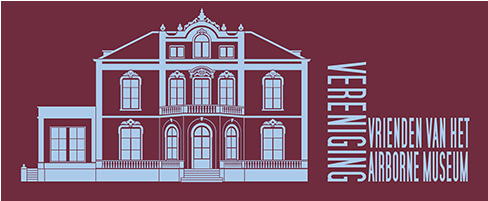






 ine restored zz radio set that teas unearthed at the corner of Kneppelhoutweg and Hoofdlaan almost 50 years after the Battle of Arnhem. J
ine restored zz radio set that teas unearthed at the corner of Kneppelhoutweg and Hoofdlaan almost 50 years after the Battle of Arnhem. J 19 September 1999. In a long column of more than 100 old military vehicles the veterans are driven around the villages of the Municipality ofRenkum (Photo: Berry de Reus)
19 September 1999. In a long column of more than 100 old military vehicles the veterans are driven around the villages of the Municipality ofRenkum (Photo: Berry de Reus) Niall Cherry, author of the book ‘Red Berets and Red Crosses’, photographed in front of‘De Tafelberg’ in Oosterbeek. He is holding the parachute helmet of Corporal Ken Holdsworth, 181 Airlanding Field Ambulance, who worked there in 1944.
Niall Cherry, author of the book ‘Red Berets and Red Crosses’, photographed in front of‘De Tafelberg’ in Oosterbeek. He is holding the parachute helmet of Corporal Ken Holdsworth, 181 Airlanding Field Ambulance, who worked there in 1944.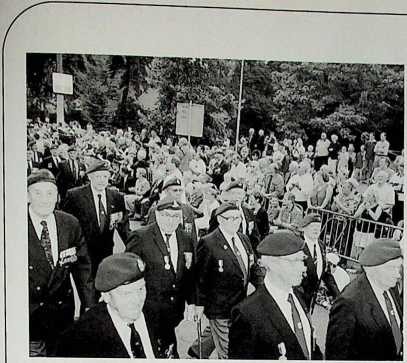
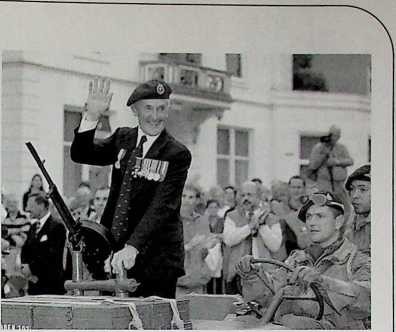 Standing on a jeep. Brigadier Mike Dauncey leads the Farewell Parade.
Standing on a jeep. Brigadier Mike Dauncey leads the Farewell Parade.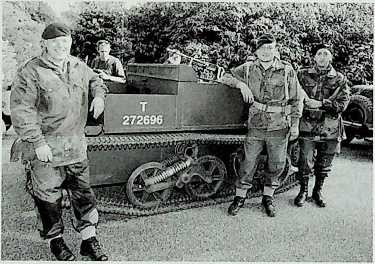



 Mr M. Kremer of the Dutch Air Mobile Brigade, and Mr J. Elliott, the youngest British Air Despatcher, press the button simultaneously, to open the ‘Green On’ exhibition in the Airborne Museum ‘Hartenstein’ on 19 April 2000.
Mr M. Kremer of the Dutch Air Mobile Brigade, and Mr J. Elliott, the youngest British Air Despatcher, press the button simultaneously, to open the ‘Green On’ exhibition in the Airborne Museum ‘Hartenstein’ on 19 April 2000.






 The Horsa glider which made a premature landing near Melksham in Wiltshire, England on 17 September 1944. (photo: via Niall Cherry)
The Horsa glider which made a premature landing near Melksham in Wiltshire, England on 17 September 1944. (photo: via Niall Cherry)






